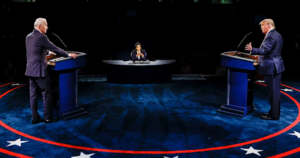As 2020 continually solidifies itself as one of the more rigorous periods in United States history, the nationwide civil unrest and protesting is becoming increasingly detrimental to national security and the country’s basic civility.
Since May 26, the day after 46-year-old African American George Floyd was killed during an attempted arrest by Minneapolis police officers, the nation has nearly turned itself upside down. Protests began locally within the Minneapolis–Saint Paul metropolitan area. For the most part, these protests were peaceful groups hoping to honor the recently deceased African American victim of police brutality.
Unfortunately, what began as a peaceful movement raising awareness of racism and the justice system’s oppression of minorities degenerated into all-out havoc. On May 27, BuzzFeed News reported that the area’s protests now had over 11,000 protesters, and later that evening, a three-night long riot of felonious activity began.
Minnesota Gov. Tim Walz ordered the deployment of the state’s national guard, the largest deployment of its troops since World War II. Seventy-two hours later the city of Minneapolis and its surrounding area suffered extensive damages. According to the Star Tribune, “about 330 buildings across [Saint Paul] sustained some damage, with most of the destruction along University Avenue, according to a report the city’s Planning and Economic Development department presented to City Council members. … The financial tolls include about $73 million in property damage, plus $8.8 million in loss of inventory and other business assets.”
The same article continues: “‘Many of the businesses were already suffering as a result of the COVID-19 pandemic,’ said Economic Development Director Martin Schieckel. But after spending $3.3 million of the St. Paul Bridge Fund to help families and businesses that lost income as a result of the pandemic, he said the city has had to direct damaged businesses elsewhere, including state and federal programs.”
A troublingly large percentage of damaged properties are local small businesses, some owned by African Americans and other minorities. By June 19, Minneapolis and its surrounding area suffered two murders, 619 arrests and a steep bill of $500 million in damages across 1,500 properties. Despite this, protests spread to 140 cities across the nation, producing destruction in varying degrees. .
Since the 1950s, Property Claim Services (PCS) has effectively monitored claims involving acts of civil disobedience. They qualify anything resulting in a cost of $25 million or more as a “catastrophe,” and according to an article published by AXIOS, the company reports that the “unrest from this year (May 26 to June 8) will cost the insurance industry far more than any prior one.”
Regarding the total cost, “that number could be as much as $2 billion and possibly more, according to the Insurance Information Institute (or Triple-I), which compiles information from PCS as well as other firms that report such statistics.” According to Verisk Analytics, “the insured losses far outstrip the prior record of $775 million from the 1992 Rodney King Demonstrations.”
Beyond the financial loss, FBI data indicates that as of July 13, the year 2020 has endured a 28% surge in police officers killed in the line of active duty. Most of these deaths occurred after the death of George Floyd. Adding to the loss of life, Forbes claims that as of June 8, there have been at least 19 known fatalities.
Contextualizing this nationwide protest is necessary when attributing blame or determining where exactly the protests transformed into mindless destruction and crime. As of Sept. 22, the U.S. suffered its 200,000th death from the coronavirus, according to data provided by Johns Hopkins University. The U.S. continues to lead the world in the number of confirmed cases and deaths. Many across the nation experiencing financial distress, sickness, anxiety, tragedy and more while stuck under quarantine, reached their breaking point on May 25.
Regardless, there is no reasonable justification for murder, violence, destruction of public or private property, especially when it is done to venerate a departed victim or an effort to enact societal change. Throughout these protests, several of the nation’s leading news media outlets have undoubtedly exacerbated the situation. Whether their reporting paints all protesters as anarchists who are fully aligned with the Black Lives Matter movement to truthfully report the damages from some of these protests, truth must be reported wholly and civil discourse revived.










Be First to Comment